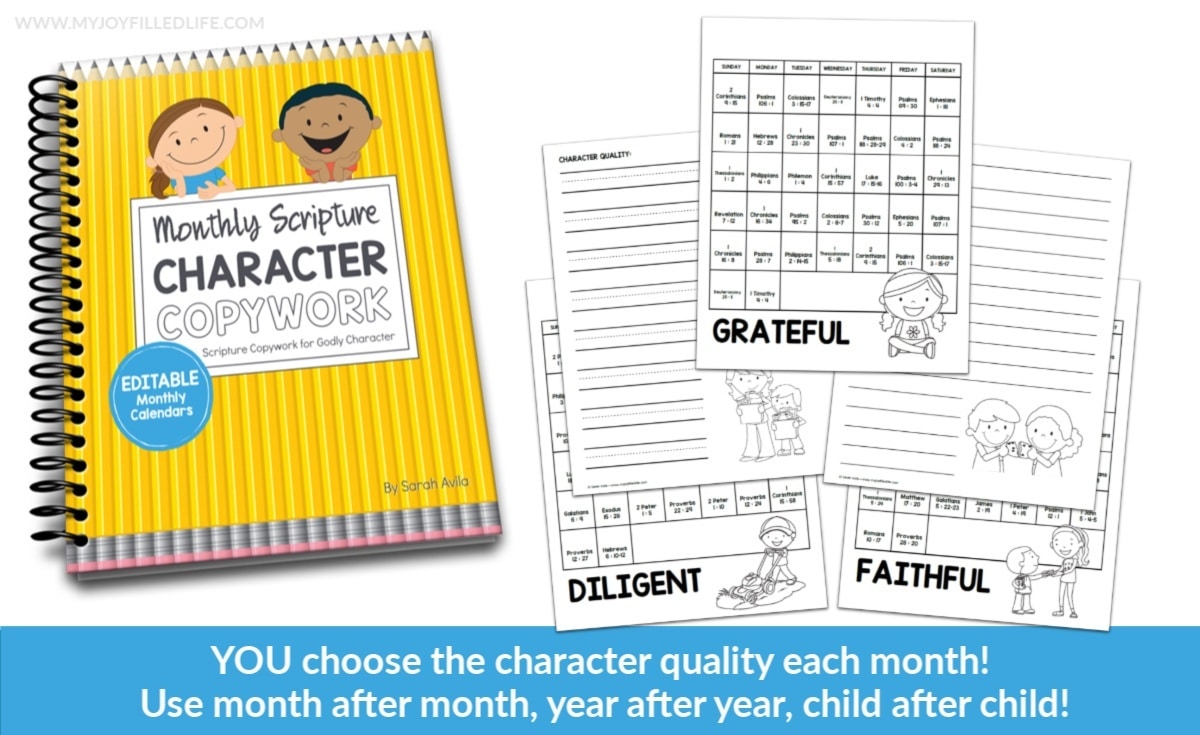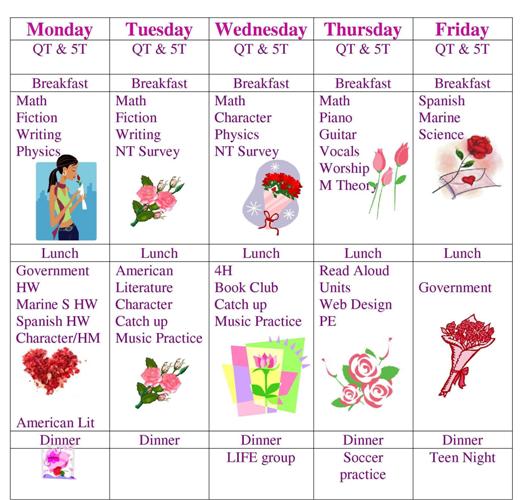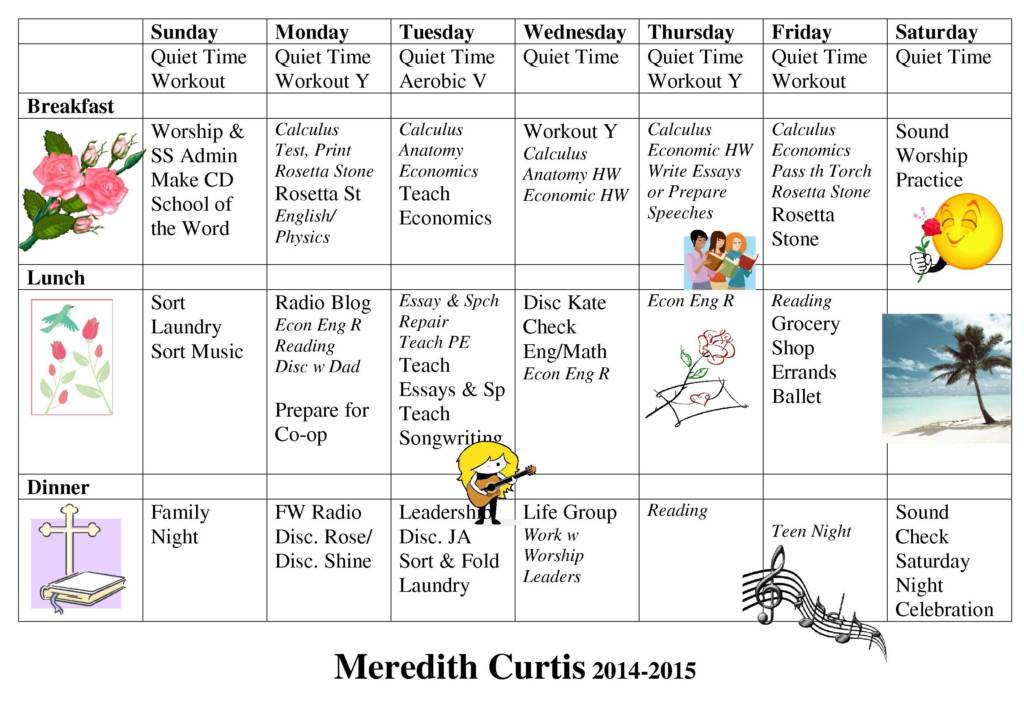“My schedule?” I asked my grandfather. “You want my schedule?”
“Yes, I’ll put it on the board and pray for you throughout the day,” he replied.
I definitely wanted that! So I gave him a schedule with all my classes and my weekly Bible study.
The next semester, as I was making the schedule for Gramps, I decided to keep a copy for myself and fill in all the other things I did during the week — just to see what I was actually doing every week.
It surprised me! It also made me think about being more efficient in the use of my time. So, in college I began to use a schedule that used time slots. I created it myself with pretty colors and hung it on my wall.
Now, let me be honest. I never felt uncomfortable veering off my schedule for any reason. I saw the schedule as my servant, not my master.
Fast forward 10 years and I have a baby and a toddler. There was no way a schedule like I used in college would work for me now. I had no sense of time each day — I moved from one thing to the next, hoping I would find time each evening to cook dinner.
A few years later there were three, then four, then five children. I was homeschooling and my husband was in ministry. Suddenly, I was overwhelmed by all the things I was doing and I needed some order. When I tried to make a schedule with time segments, it freaked me out. How did I know when my baby would need to nurse or the toddler would empty the garbage can all over the kitchen floor. I felt out of control with my time and wasn’t sure how to bring some order into my life.
Enter Block Scheduling
Here is a blank schedule I created in Word by inserting a table with 7 columns and 8 rows.
I don’t know how or when I discovered block scheduling, but it changed my world!
I created schedules with blocks of time: before breakfast, between breakfast and lunch, between lunch and dinner, and after dinner. Each day had four blocks and no times listed. It was very freeing. It fit in with my crazy world perfectly. We had to eat so they made perfect divisions for our days.
Next, I sat down and made a schedule that would work for my family.
I sat down with the first block. The only thing I would try to do before breakfast was read the Bible and pray.
Now for the second block. I thought about what was best for our family to do in the morning before breakfast. For us, the sitting and writing stuff like math and spelling worked better in the morning, but I also wanted us to pray together and read the Bible.
I would put snuggling and reading aloud after lunch when our energy level was a little lower.
I looked through our schoolwork and put most things in the morning with a light afternoon. That worked best for us! Afternoons would be reading aloud, playing, reading on their own, and tidying up the house right before Daddy came home.
After dinner would just be tidying up the kitchen, baths, and bedtime rituals, except for the nights we had church meetings or company for dinner.
Then I added laundry (all day Tuesday), cleaning house (everyone together Saturday mornings), and field trips (Friday).
I loved using block scheduling and our schedules were constantly being tweaked until they worked.
Personal Schedules
Jenny Rose’s junior year schedule
As the kids got older, the schoolwork load increased, especially in high school. Our lives were definitely busy! I began making personal schedules for each child using blocks of time instead of hours.
Some of my children wanted to do a weeks’ worth of one subject in a single day. Others wanted to do each subject every day. Of course every teen was different. We worked on schedules together that worked for them. (Look at the photos to see samples). We would make a schedule, try it out, tweak the schedule, and repeat as needed. Again, we used block scheduling because it allowed for more flexibility.
As a mom, I made a master schedule for myself once all the schedules were tweaked so that I knew what everyone was up to. That way I could schedule being available to each child when they needed me. I could also fit in working out, grading papers, and shopping around homeschooling.
I made all these schedules in Word by just inserting a table with 7 columns and 8 rows. Then I filled in the days of the week, breakfast, lunch, and dinner. I printed them to let the kids fill them in or to work on my own. Afterward, I typed everything up and added clip art to keep it fun!
Every Family is Different
Our family is a heavily involved in church ministry and hospitality. As the kids got older, music and worship team increased our busyness. We had to make time for all these things, but still get school done and have time that was just family.
We scheduled in family night for Sunday evenings. At first family night seemed silly because we were together all day, but as kids graduated and went to college and work, this became a treasured time for all of us.
Our family wanted to eradicate wasting time and make sure that free time was fun and relaxing because we were such a busy family.
How about you? What scheduling needs to you have?
Benefits for Our Family
My schedule. The kids’ courses are in italics.
The benefits of scheduling were widespread with our family. We learned to be efficient in the use of our time. We discovered that if something came up, we still had to get the things done that we usually got done during that block of time. So we learned to use our free blocks or spread it all out over the next few days. Time became a valuable commodity that we didn’t take for granted so we appreciated our free time.
The long-range results of finding a schedule that worked for us is that all of my children manage their time well. I don’t see them waste time. They get hard work out of the way before they play. They also check their calendars before making commitments because they know there is only so much time in a day or week.
I am amazed at the good fruit of scheduling long-term. When I started using a schedule, I just did it to keep my sanity, so the bathroom would get cleaned regularly, and the kids would keep up with their schoolwork. It turned out to have a huge impact on my family in a positive way.
When people ask, “How do you and your children get so much done?,” I quickly reply, “Block scheduling. We don’t work harder, we work smarter.”
Tips for Using a Schedule
Schedules have been such a blessing in our family because they keep us working smarter not harder. We are more efficient with our time because of our schedules.
Here are some tips to using schedules in a way that will make your life happier:
- Remember a schedule is a servant, not a master
- Keep tweaking a schedule until it works for you
- Don’t try to use another family’s schedule—find what works best for you
- Leave blocks of free time
- If you schedule a doctor’s appointment or something similar in a block of schoolwork time, then make sure you make up that time in another block of time
- Leave blocks that can be used for overflow (we used Fridays as field trip days or “catch up” days
- Keep your schedule flexible so that you have room to spend more time on one thing and less time on something else
- Cultivate habits that support time management like making your bed each morning and bringing your school books downstairs or putting school books away as soon as a child finishes school
- Keep the atmosphere in your home cheerful—“It’s time for breakfast! Good morning sleepyheads!”
- Keep your schedule pleasant, not overwhelming. In Psalm 16, the Lord tells us that His boundary lines fall in pleasant places. Imitate the Lord. Let your schedule boundary lines fall in pleasant places, too.
This season of homeschooling goes quickly, so I want to make it as peaceful and joyful as possible. With the goal of joy and peace, practical scheduling has been a blessing to our family. I encourage you to consider block scheduling if your home is full of different ages and/or is a busy household. It is easy to use block scheduling and it provides a flexible structure that most homeschooling families can thrive in.
Meredith Curtis, pastor’s wife, homeschooling mom of five amazing children, and grandmother to 3, loves Jesus, leads worship, homeschools, writes, mentors ladies, and sometimes even cooks dinner! She believes that all of life is a grand adventure with so much to learn and discover about Jesus. She is the author of Joyful and Successful Homeschooling, HIS Story of the 20th Century, Americana Newspaper Reporting, and God’s Girls Beauty Secrets, as well as Bible studies, unit studies, curriculum, and high school courses. Meredith wants to encourage Christian families to enjoy a joy-filled life homeschooling journey. Visit Meredith at Powerline Productions, Joyful and Successful Homeschooling, MeredithCurtis.com, Finish Well Homeschooling Podcast, and Facebook.














